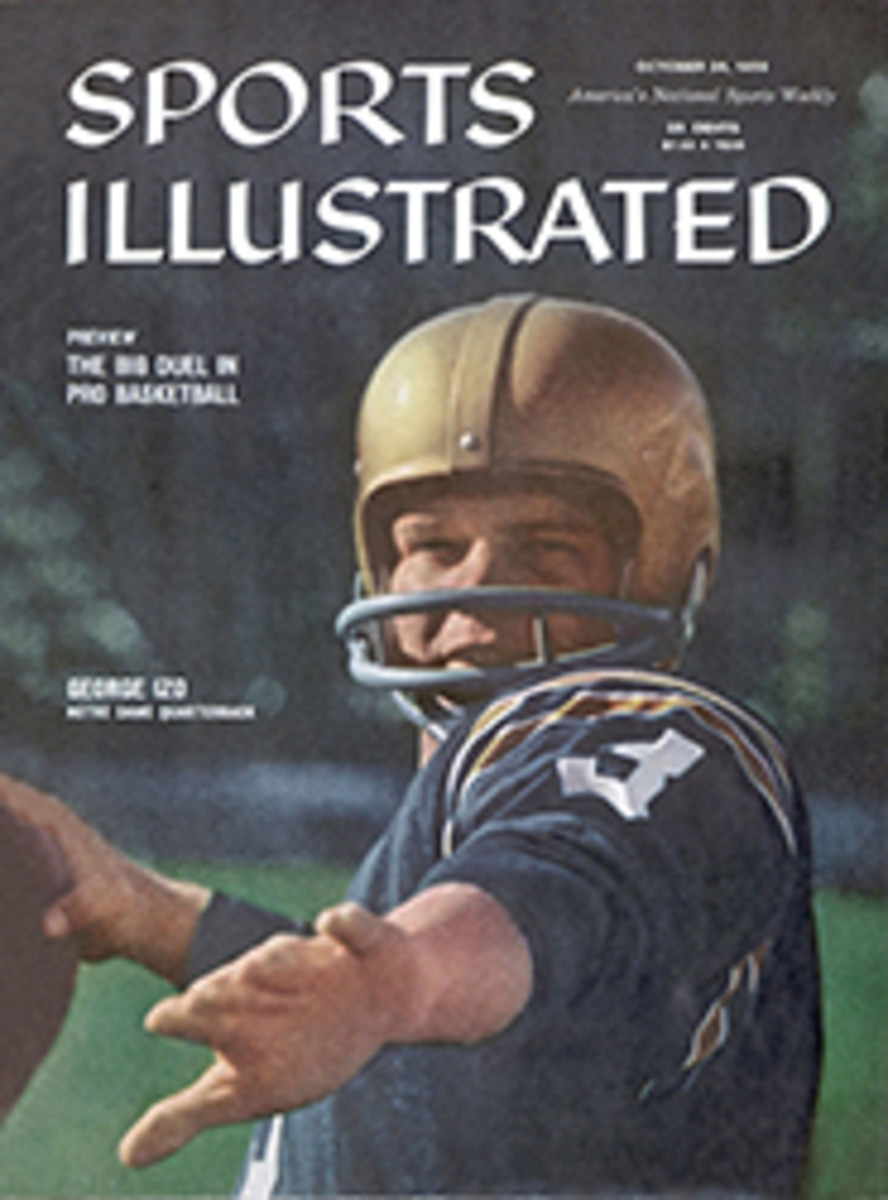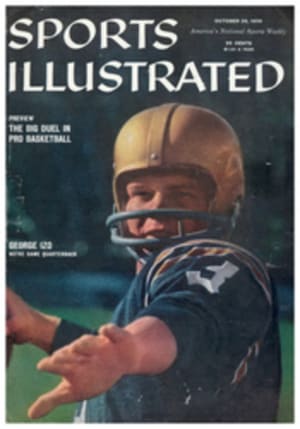
The almost no-water boat
The fast 16-footer at the top of the page is churning through some pretty shallow water, a practice that is obviously most unwise for any inboard. In this case, however, there is nothing to worry about. The boat is the radically different Buehler Turbocraft with a tough fiber-glass bottom and—as the drawings on the next pages show—it has no reason to fear for its propeller. In fact, it has none. The propeller has been replaced by a stream of water, the so-called water jet method of propulsion.
The boat is manufactured by Turbocraft Division of Indiana Gear Works, Inc., which is now turning them out at a rate of nine hulls a day. Last week SPORTS ILLUSTRATED tested one of the early models. It was an experience as interesting as it was at times startling. To begin with, the engine drives the boat by inhaling water through a grille in the bottom and pumping this same water rapidly out at the stern. The pump is a water turbine driven by a standard inboard engine. The propulsion principle is the same as that of a jet aircraft, depending directly on the basic law of motion that says every action must have an equal and opposite reaction. If water is ejected astern, the boat in turn must move forward.
The idea of water jet propulsion is not new; it has been tried before but never with commercial success. Engines were generally too bulky and too expensive, and the boats too slow. The Turbocraft's successful water jet system is the invention of a New Zealander, Bill Hamilton. Industrialist Hamilton spent seven years and half a million dollars working out the principles necessary for good water jet propulsion. He decided—correctly—to let his jet empty above rather than below the water. (Air provides less resistance than water—a simple deduction that some of Hamilton's predecessors in the water jet field ignored.) He eliminated the bottom appendages that many of the early water jets used—scoops and rudders and such. He used a turbine (his own design) rather than a centrifugal pump with its less efficient flow pattern. And he took the trouble to design a flow system along curves that gave maximum thrust for the amount of energy expended in pumping.
The result was that New Zealand had a successful Hamilton Marine Jet for three years before the idea was bought and brought to the U.S. by John Buehler, president and owner of Indiana Gear Works, Inc., which currently is operating on a $12 million annual gross. Buehler was looking around for diversification of his operations when the Hamilton Jet was brought to his attention. Within an hour he had a wire off to Hamilton. The wire read: "Ship one Hamilton Marine Jet, air express."
That was January. Buehler produced his first Turbocraft version of the marine jet this May. He was quick to see that the turbine system designed by Hamilton was inherently more efficient than a propeller system. The water in a turbine is confined within the tube in which the blades rotate, so there is very little slippage between water and blade compared to the slippage that occurs in conventional propeller operation in unconfined liquids.
Driving the Turbocraft off Long Island last week, I had ample proof of the system's efficiency. I found that the Turbocraft accelerated from dead in the water to 30 mph in about 15 seconds. Top speed is about 32 mph—very good for the 109-hp Gray Marine that powered this particular Turbocraft. (Fuel consumption claimed for the Turbocraft is a not unlikely 10% lower than that of comparable boats.) The boat's maneuverability is considerably beyond that of any boat I have driven. As an example, I learned I could take the boat up to top speed, put the wheel hard over and fling the boat into a full 180° turn in its own length. This astounding maneuver is possible because there is no prop or rudder to trip the hull. Experienced Turbocraft test drivers perform the 180° turn within 15 feet of a dock, stopping it dead at dockside.
There are other things you can do with this water jet. You can set the wheel over at slow speeds and the hull will circle indefinitely and under control within a distance slightly greater than its own length. At full speed a test driver can shove the boat into reverse and be making sternway in a single boat length. And you can go anywhere: through heavy marsh grass, over submerged stumps, across mudbanks—all you need for a planing run is three inches of water.
During the test runs I had a chance to work the boat both on smooth creek water and a good stiff chop in Great South Bay. In flat water she moved at trolling speed (down to 2 mph) without fuss and in good control. Out in the chop she behaved well on the straight runs (although she's not an exceptionally dry hull). Cornering in a chop the boat proved considerably superior to the normal prop inboard. The Turbocraft banks and gets her outside chine so quickly out of harm's way it has no chance to catch and turn the boat over. Short of running her sidewise down an eight-foot breaker, it's hard to see how the boat could be made to turn turtle.
There is, however, a debit side to the picture. In order to change direction at slow speeds, for instance, you have to give it a short burst of power. The boat starts turning very quickly thereafter, but the need for a moment of acceleration is a handicap in close quarters. Another disadvantage is that the boat has no steering in reverse. It will back up in a straight line, but will not turn to either side. In order to head it in another direction you have to go into forward, get the new heading and then back the boat. Cavitation (overrevving because of air in the turbine) is only a problem in exceptional circumstances, such as riding off a really high wave that takes the grille out of water for a period of several seconds, a combination of circumstances that would be caused only by bad judgment and bad luck.
Mechanically, the boat has two weak points. One is the forward-reverse control mechanism which has to be held down an extra second or two to insure that the control gate is in the proper place (see drawings below). This, says Buehler, is in the process of being corrected by the introduction of a push-button system. The second weakness is the thrust bearing of the turbine—it must be watched to see that it does not run dry. The strain on it makes it difficult to keep it perfectly sealed.
Visually, the fascinating characteristic of the Turbocraft is the stream of water it throws. Although it drops into the water three or four feet behind the transom under normal running, the stream occasionally forms a rooster tail of spray which can blast back 30 feet or so under the right conditions (one: a full throttle start from dead in the water). Right at the transom opening the jet of water is coming out of the turbine at about 65 mph. If you should happen to be hanging on to the transom behind the jet opening when the driver guns the throttle to wide open, you would feel as if someone had given you a hard kick in the head. However, at speeds up to three or four knots you can hang your head in the jet stream without getting anything more than a stinging washdown. This makes Turbocraft a safer boat for handling water skiers and swimmers than any prop craft could be.
Buehler's Turbocraft Division is now in full swing; it will have 800 Turbocraft on the market by the end of the year (16-footers with choice of several marine engines). Then Buehler will shift to newer models. The first will be an improved 16-footer and a new 18-footer. There will also be a 23-footer in 1960. The boats will sell for about the same as inboards of comparable performance: the savings in construction (no shaft, gears, props or strut problems) cover the cost of the turbine.
Time, of course, is the final arbiter of the worth of a new design. But if the Turbocraft stands up to normal use and wear in the hands of its new owners in the next year or so, the future for propellers in the inboard field may look as dark as Mr. Buehler's future looks bright.
PHOTO
SHOOTING THROUGH SHALLOWS OFF SAND BAR, PROPELLERLESS TURBOCRAFT SHOWS IT CAN HIT TOP SPEED IN FOOT OF WATER
DIAGRAM
POWER PLANT of Turbocraft is inboard engine (1) which transmits power through drive shaft (2), universal coupling (3) and thrust bearing (4) to turbine shaft (5). Water (see arrows) is drawn up through grid (6) in bottom of Turbocraft by whirling impeller blades (7) and directed astern first by reactor stator (8), then by booster stator (9) and straightening stator (10). Stream of water is speeded up as it leaves boat by passing through narrow nozzle (11). Boat is steered by means of deflector gate (12), which is turned from one side to the other by steering cables attached to quadrant (13). Forward-reverse gate (14) is moved up and down by hydraulic pump (15) (see diagrams below). Engine-cooling water is taken off by tap (16).
1
2
3
4
5
6
7
8
9
10
11
12
13
14
15
16
DIAGRAM
FORWARD motion results when the gate (dark line) is drawn up to highest position so jet stream shoots directly astern.
DIAGRAM
IDLING position of gate, halfway down, causes jet stream to be bottled inside turbine, robbing turbine of its entire thrust.
DIAGRAM
REVERSE motion occurs when the water stream is directed forward under hull by lip of control gate in its lowest position.
PHOTO
JET COMES OUT GENTLY AT LOW SPEED

